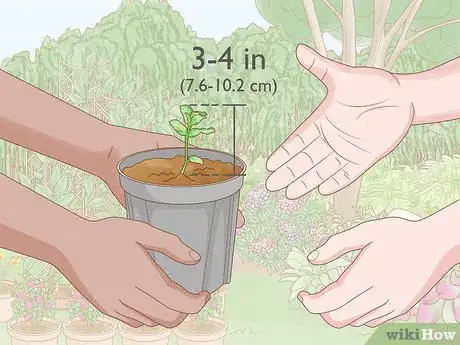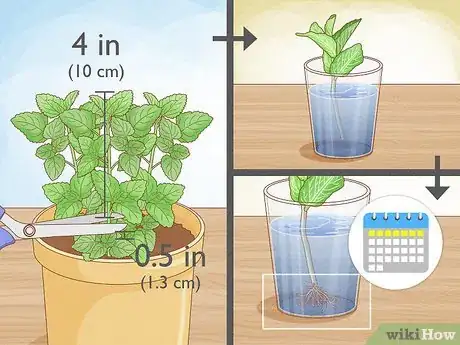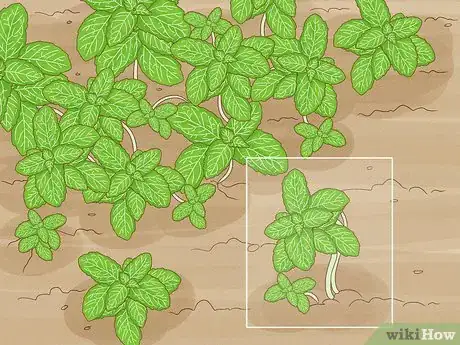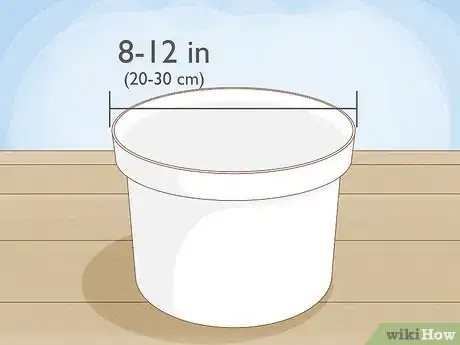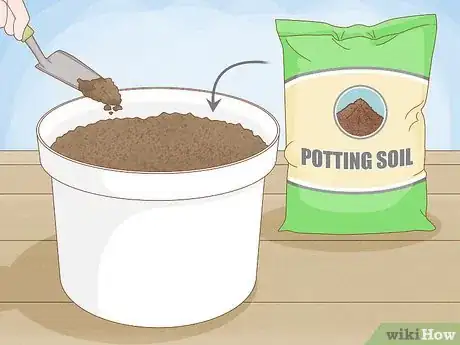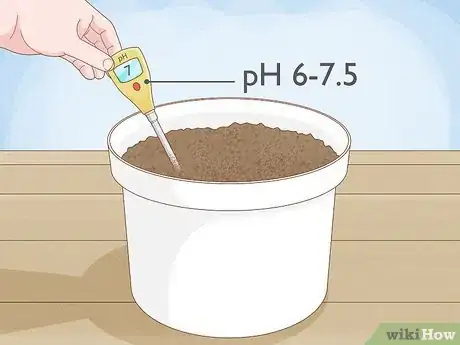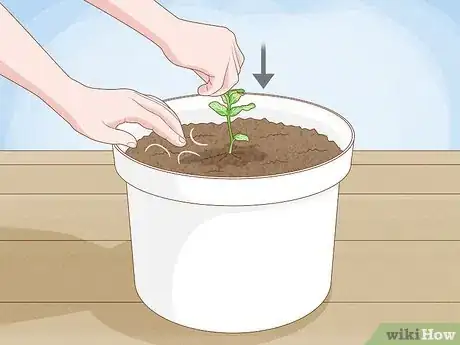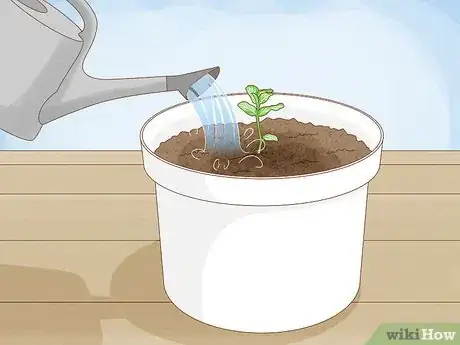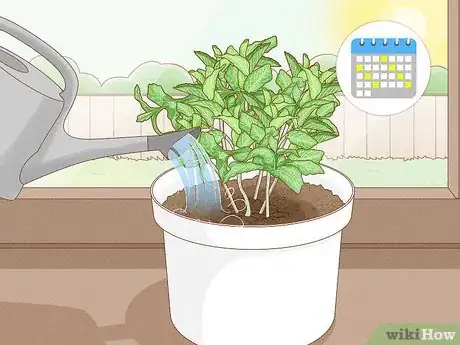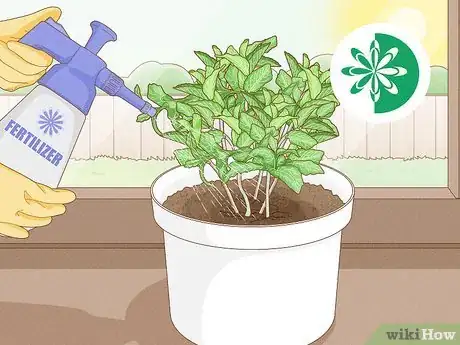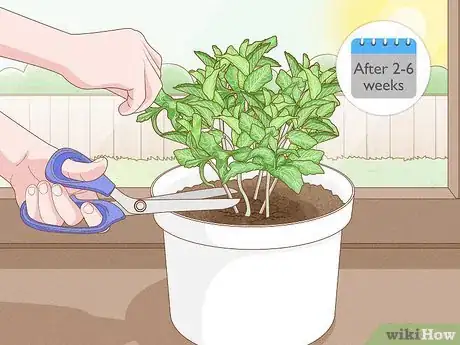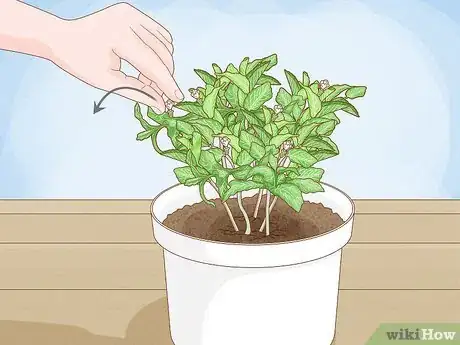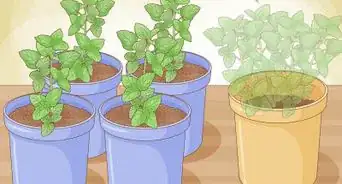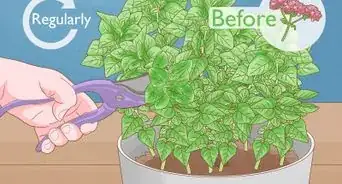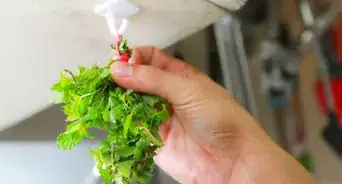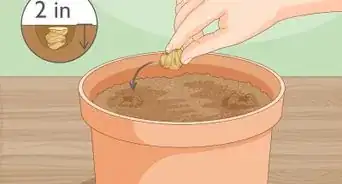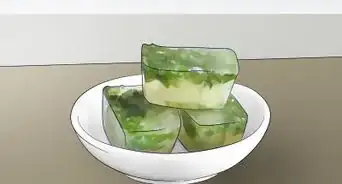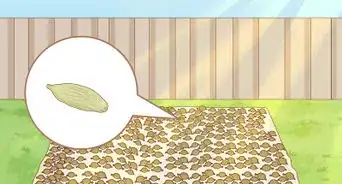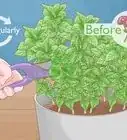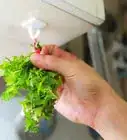This article was co-authored by Maggie Moran. Maggie Moran is a Professional Gardener in Pennsylvania.
wikiHow marks an article as reader-approved once it receives enough positive feedback. In this case, 87% of readers who voted found the article helpful, earning it our reader-approved status.
This article has been viewed 65,574 times.
Mint is a lovely, low-maintenance plant with a wide variety of applications in food, drinks, and household products. Mint grows best as a potted plant, so it is a lovely plant to grow indoors. If you'd enjoy growing mint in your home,all you need to do is acquire a mint seedling, re-pot it, and perform some routine care. Then you can harvest your mint as needed to make mojitos or mint tea.
Steps
Acquiring a Mint Seedling
-
1Purchase a mint seedling. Mint plants are notoriously difficult to begin from seed. Instead, visit your local nursery (or even sometimes your local grocery store) and purchase a mint seedling. Look for a seeding that is already at least 3–4 inches (7.6–10.2 cm) tall.[1]
- Some varieties of mint include sweet mint, chocolate mint, spearmint, lemon mint, apple mint, and peppermint.
- Spearmint and peppermint are the most common. Spearmint is often used in baking and cooking. Peppermint is used more often for drinks, like mojitos and hot chocolate.
-
2Propagate a new mint plant from a cutting. Trim a 4 in (10 cm) sprig from an existing mint plant, about 0.5 inches (1.3 cm) above a junction. Place the trimming in a glass of water, and wait about 1 week. Small white roots should begin appearing under water. Wait another 2-7 days to allow the roots to develop.[2]
- Add water to the glass as necessary.
- Change the water every 4-5 days to keeping your trimming healthy.
Advertisement -
3Use a “runner” from an existing outdoor mint plant. If you have a friend with an existing outdoor mint plant, you may be able to use one of their runners. “Runners” are long stems that grow away from a mint plant. Runners set their own roots in the ground, which means they can be carefully removed and transplanted into a new pot. Look for a runner, and use a trowel to gently remove it from the ground.
Planting Your Mint
-
1Find a container with a wide surface. Mint plants needs a lot of width to grow effectively, but they don’t need a great deal of depth. For each mint plant, look for a container at least 8–12 inches (20–30 cm) wide.[3]
- Ceramic planters are porous and lose moisture easily. Your mint might be happier in a plastic container.
- You can repurpose a plastic container by drilling a hole in the bottom for drainage.
-
2Fill your container with potting soil. You can pick up some potting soil from a local nursery, home improvement store, or big box store. Mint plants enjoy soil that drains well, so don’t pack the soil too tight.[4]
-
3Test your soil for a pH of 6-7.5. Mint plants are not super finicky, so they will accept a relatively wide pH range. Use a test kit to make sure your soil falls within this optimal range.
- To lower the pH of your soil, add some compost, composted manure, or acidic mulch.
- To raise the pH of your soil, add pelletized lime or wood ash.
-
4Place your mint seedling in the container. Using a small trowel and/or your fingers, make a small opening in the soil. Carefully place your mint seedling into this opening. Move the soil around your seedling so that the roots are no longer exposed, and your seedling can stand up.[5]
- Indoor mint plants do not require fertilizer or mulch.
-
5Water your seedling immediately after planting. Once you've gotten your mint plant in the soil, give your seedling a generous watering. For one mint plant, offer around 6–8 fluid ounces (180–240 ml) of water.[6]
Caring for Your Mint
-
1Place your mint plant so it receives indirect sunlight. Choose an area that receives morning sun and partial afternoon shade. You want the plant to get some light without drying it out completely. [7] Rotate your plant every 3-4 days. Mint plants will grow in the direction of sunlight, and rotating the plant helps to keep it from growing unevenly.
- Some good options include:
- A windowsill that faces north.
- A shelf across the room from a south-facing window.
- Some good options include:
-
2Water your mint frequently. Water your mint at least every 2-3 days, or more if you live in a very dry climate or your mint is getting a lot of direct sunlight. Check the soil with a finger each day to ensure that the soil is moist.[8]
- Add around 1–2 cups (240–470 ml) to your mint plant at each watering.
- Humidity can be important to the growing process, so consider misting your plant with water in between waterings.
-
3Use water soluble fertilizer if desired. Mint plants do not often require fertilizer, but it can help improve your plant's growth if used occasionally. The best time to use fertilizer is in the spring when plants first start the new growing season.
- Choose a water soluble, time-release fertilizer.
- Too much fertilizer can alter the taste of your mint.
-
4Harvest your mint leaves. Give your new mint plant anywhere from 2-6 weeks to get established. Then begin plucking off leaves as you need them. Avoid harvesting more than ⅓ of the plant at one time, as this can prevent proper regrowth.[9]
- Hang mint stems upside down to dry them.
- Save mint leaves in an airtight container, like a jar or a small plastic bag.
-
5Remove any flower buds before they open. Although the flowers that appear at the top of your mint plant are pretty, you’ll need to trim them off as soon as they appear. Use a pair of sharp scissors to clip the flowers off at the stem to prevent fewer, blander mint leaves.[10]
- This prevents the plant from “going to seed.” When a mint plant starts producing seeds, it puts less energy toward leaf production.
Expert Q&A
Did you know you can get expert answers for this article?
Unlock expert answers by supporting wikiHow
-
QuestionHow much sun does a mint plant need?
 Maggie MoranMaggie Moran is a Professional Gardener in Pennsylvania.
Maggie MoranMaggie Moran is a Professional Gardener in Pennsylvania.
Home & Garden Specialist
-
QuestionWhat are the best herbs to grow indoors?
 Maggie MoranMaggie Moran is a Professional Gardener in Pennsylvania.
Maggie MoranMaggie Moran is a Professional Gardener in Pennsylvania.
Home & Garden Specialist
-
QuestionCan you keep a lavender plant indoors?
 Maggie MoranMaggie Moran is a Professional Gardener in Pennsylvania.
Maggie MoranMaggie Moran is a Professional Gardener in Pennsylvania.
Home & Garden Specialist
Things You'll Need
- Mint seedling or existing mint plant
- Container
- Soil
- Water
- Scissors
References
- ↑ http://www.gardeningblog.net/how-to-grow/mint/
- ↑ http://foodiegardener.com/grow-mint-indoors-spearmint-and-peppermint/
- ↑ http://foodiegardener.com/grow-mint-indoors-spearmint-and-peppermint/
- ↑ https://www.almanac.com/plant/mint
- ↑ https://www.almanac.com/plant/mint
- ↑ https://www.almanac.com/plant/mint
- ↑ https://www.almanac.com/plant/mint
- ↑ http://www.bhg.com/gardening/vegetable/herbs/grow-mint-plants/
- ↑ https://www.almanac.com/plant/mint
About This Article
To grow mint indoors, buy a mint seedling from your local nursery. Next, fill a wide planter with potting soil that has a pH between 6 and 7.5, plant the seedling, and water it thoroughly. Place the container in an area where it will receive plenty of indirect sunlight and water it every 2-3 days. After about 6 weeks you can start harvesting mint leaves. Don't forget to snip off flower buds as they appear so the plant will focus on leaf production! For tips on propagating mint from a cutting, read on!
